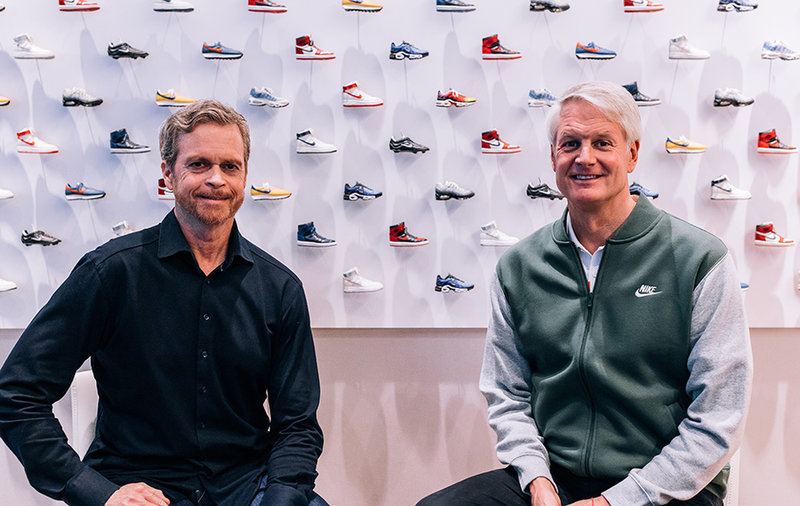What’s in store for Nike as Donahoe takes charge?
It's all change at the top for Nike Inc after John Donahoe in January took over the reins as the company's fourth CEO in its 55-year history. But with a background in technology rather than retail and sportswear, what’s likely under his leadership? By Hannah Abdulla
CEO Mark Parker has stepped aside after nearly 14 years at the helm of the sportswear giant. John Donahoe, the CEO of cloud computing company ServiceNow, and president and CEO of eBay between 2008 and 2015, steps into his shoes.
Parker will continue to lead the board of directors and work closely with Donahoe, who has been on the board of Nike since 2014. But with the company looking to bolster its digital presence, Donahoe's expertise is likely to be key in driving the business forward.
Growth in digital is already delivering results for Nike, and is at the heart of its Consumer Direct Offense fuelled by the brand's 'Triple Double' strategy: 2X Innovation, 2X Speed and 2X Direct connections with consumers.
In its second-quarter, the company booked a 32% jump in profit to 30 November, and noted its two apps – the Nike app and the SNKRS app – were "outperforming all other channels" driving digital growth of 38% during the quarter.

John Donahoe (right) has taken over from Mark Parker (left) as Nike Inc president and CEO
Driving direct-to-consumer
Nike is looking to interact with its customers more directly and has already taken steps to cut ties with third-party retailers such as Amazon. Reducing its wholesale distribution list and getting more customers to shop directly with Nike is something Donahoe will look to double-down on, believes Honor Strachan, lead retail analyst at data and analytics firm GlobalData. Part of this is going to involve investments to incorporate new technologies, making the digital proposition – the website and apps – so great that shoppers don't need to go via a third-party retailer. A big focus for Nike is building communities and being a pillar or a discussion hub when it comes to fitness and wellness. Again, direct links with customers will enable it to do this on a wider scale.
Upping digital capabilities
Over the last couple of years, Nike has invested significantly to try and engage shoppers across all channels. By incorporating online and its apps within the store experience it has made significant headway. One example is the Nike app at retail, which sees personalisation and convenience move to another level. Inside the store, members can unlock tailored offers based on their past engagement with Nike and shop at their pace on the retail floor, scanning products for information and checking out on their own. Investments in RFID also enable customers to track a product they want when in-store.
All this has made a massive difference in terms of how consumers can shop and engage with Nike online and has made it a serious player when it comes to a multichannel proposition. "We can definitely expect to see more of this: whether using more augmented reality, so customers can put shoes on remotely and see how they look; or foot scanners taking a photo of your foot and the app recommending the right fit for you. All these things I'd expect to see more of to create greater convenience for the shopper and grow its presence as an online retailer," says Strachan.
Predictive analytics
Leveraging its digital capabilities are also key to delivering what consumers want. In August Nike acquired Celect, a predictive analytics platform that helps it anticipate consumer needs and optimise inventory across multiple channels. The company says it is applying and developing new unique algorithms to make it better attuned to its customers, leveraging data that includes past and present interest in products and purchasing signals to better predict supply and demand, enabling more accurate positioning of inventory in stores, online and in its distribution centres.
Continued product development
Parker will remain on the sidelines of the business and his expertise will continue to be crucial in terms of innovation, product design and development. Donahoe, meanwhile, is likely to focus more on strategy, growth, new markets, and the evolution of digital within the business.
Less sourcing from China
Nike is likely to continue to reduce its sourcing leverage on China, building on momentum already seen as US tariffs have taken hold. According to AT Kearney's sixth Reshoring Index, sportswear brands including Nike are diversifying towards lower-cost countries such as Vietnam. Last July the company also said it was expanding its US production footprint with a US$184m investment in a new Nike Air Manufacturing Innovation facility in Arizona. Nike should benefit from improved turnaround and lead times if it produces closer to home.
Headline image: Courtesy of pio3 / Shutterstock.com
BACK TO TOP